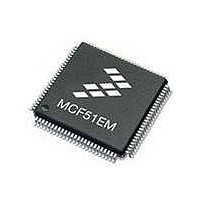MCF51EM256CLL Freescale Semiconductor, MCF51EM256CLL Datasheet - Page 286

MCF51EM256CLL
Manufacturer Part Number
MCF51EM256CLL
Description
IC MCU 32BIT 256KB FLASH 100LQFP
Manufacturer
Freescale Semiconductor
Series
MCF51EMr
Datasheets
1.MCF51EM128CLL.pdf
(2 pages)
2.MCF51EM128CLL.pdf
(54 pages)
3.MCF51EM128CLL.pdf
(636 pages)
Specifications of MCF51EM256CLL
Core Processor
Coldfire V1
Core Size
32-Bit
Speed
50MHz
Connectivity
I²C, SCI, SPI
Peripherals
LCD, LVD, PWM, WDT
Number Of I /o
63
Program Memory Size
256KB (256K x 8)
Program Memory Type
FLASH
Ram Size
16K x 8
Voltage - Supply (vcc/vdd)
1.8 V ~ 3.6 V
Data Converters
A/D 16x12b
Oscillator Type
External
Operating Temperature
-40°C ~ 85°C
Package / Case
100-LQFP
Processor Series
MCF51EM
Core
ColdFire V1
Data Bus Width
32 bit
Data Ram Size
16 KB
Interface Type
RS-232, LIN
Maximum Clock Frequency
50 MHz
Number Of Timers
3
Operating Supply Voltage
1.8 V to 3.6 V
Maximum Operating Temperature
+ 85 C
Mounting Style
SMD/SMT
3rd Party Development Tools
JLINK-CF-BDM26, EWCF
Development Tools By Supplier
DEMOEM
Minimum Operating Temperature
- 40 C
Lead Free Status / RoHS Status
Lead free / RoHS Compliant
Eeprom Size
-
Lead Free Status / Rohs Status
Lead free / RoHS Compliant
Available stocks
Company
Part Number
Manufacturer
Quantity
Price
Company:
Part Number:
MCF51EM256CLL
Manufacturer:
FREESCALE
Quantity:
110
Company:
Part Number:
MCF51EM256CLL
Manufacturer:
Freescale Semiconductor
Quantity:
10 000
- Current page: 286 of 636
- Download datasheet (11Mb)
8-bit Serial Peripheral Interface (SPI)
12.5.2
There are three flag bits, two interrupt mask bits, and one interrupt vector associated with the SPI system.
The SPI interrupt enable mask (SPIE) enables interrupts from the SPI receiver full flag (SPRF) and mode
fault flag (MODF). The SPI transmit interrupt enable mask (SPTIE) enables interrupts from the SPI
transmit buffer empty flag (SPTEF). When one of the flag bits is set, and the associated interrupt mask bit
is set, a hardware interrupt request is sent to the CPU. If the interrupt mask bits are cleared, software can
poll the associated flag bits instead of using interrupts. The SPI interrupt service routine (ISR) should
check the flag bits to determine what event caused the interrupt. The service routine should also clear the
flag bit(s) before returning from the ISR (usually near the beginning of the ISR).
12.5.3
A mode fault occurs and the mode fault flag (MODF) becomes set when a master SPI device detects an
error on the SS pin (provided the SS pin is configured as the mode fault input signal). The SS pin is
configured to be the mode fault input signal when MSTR = 1, mode fault enable is set (MODFEN = 1),
and slave select output enable is clear (SSOE = 0).
The mode fault detection feature can be used in a system where more than one SPI device might become
a master at the same time. The error is detected when a master’s SS pin is low, indicating that some other
SPI device is trying to address this master as if it were a slave. This could indicate a harmful output driver
conflict, so the mode fault logic is designed to disable all SPI output drivers when such an error is detected.
When a mode fault is detected, MODF is set and MSTR is cleared to change the SPI configuration back
to slave mode. The output drivers on the SPSCK, MOSI, and MISO (if not bidirectional mode) are
disabled.
MODF is cleared by reading it while it is set, then writing to the SPI control register 1 (SPIxC1). User
software should verify the error condition has been corrected before changing the SPI back to master
mode.
12-14
SPI Interrupts
Mode Fault Detection
MCF51EM256 Series ColdFire Integrated Microcontroller Reference Manual, Rev. 8
Freescale Semiconductor
Related parts for MCF51EM256CLL
Image
Part Number
Description
Manufacturer
Datasheet
Request
R

Part Number:
Description:
BOARD DEMO HARDWARE ONLY
Manufacturer:
Freescale Semiconductor
Datasheet:

Part Number:
Description:
IC MCU 32BIT 128KB FLASH 100LQFP
Manufacturer:
Freescale Semiconductor
Datasheet:

Part Number:
Description:
IC MCU 32BIT 128KB FLASH 80LQFP
Manufacturer:
Freescale Semiconductor
Datasheet:

Part Number:
Description:
IC MCU 32BIT 256KB FLASH 80LQFP
Manufacturer:
Freescale Semiconductor
Datasheet:
Part Number:
Description:
Manufacturer:
Freescale Semiconductor, Inc
Datasheet:
Part Number:
Description:
Manufacturer:
Freescale Semiconductor, Inc
Datasheet:
Part Number:
Description:
Manufacturer:
Freescale Semiconductor, Inc
Datasheet:
Part Number:
Description:
Manufacturer:
Freescale Semiconductor, Inc
Datasheet:
Part Number:
Description:
Manufacturer:
Freescale Semiconductor, Inc
Datasheet:
Part Number:
Description:
Manufacturer:
Freescale Semiconductor, Inc
Datasheet:
Part Number:
Description:
Manufacturer:
Freescale Semiconductor, Inc
Datasheet:
Part Number:
Description:
Manufacturer:
Freescale Semiconductor, Inc
Datasheet:
Part Number:
Description:
Manufacturer:
Freescale Semiconductor, Inc
Datasheet:
Part Number:
Description:
Manufacturer:
Freescale Semiconductor, Inc
Datasheet:











